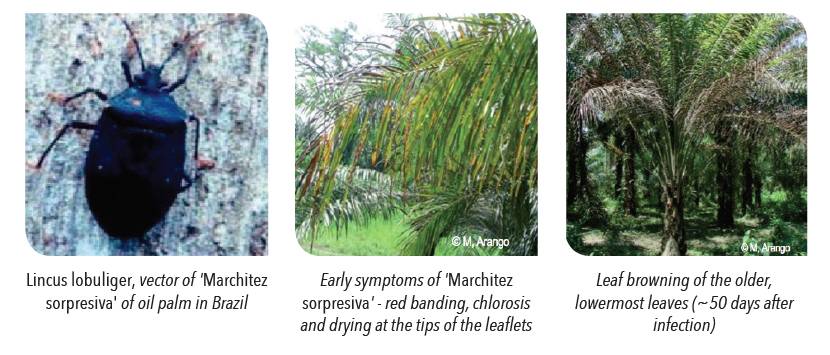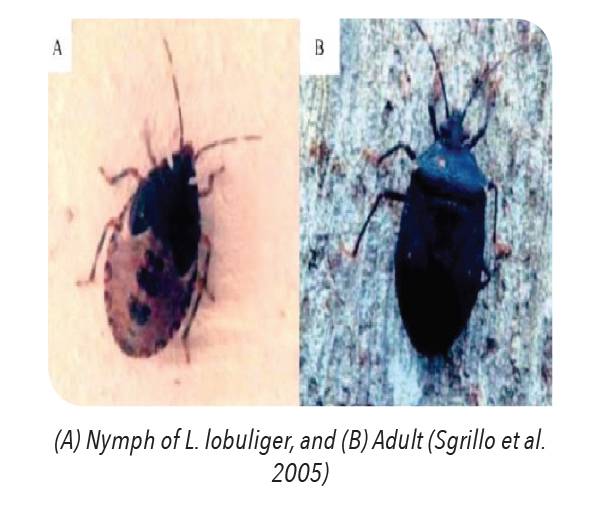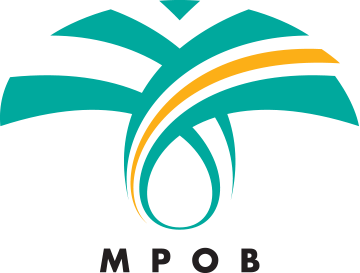General Information
Lincus lobuliger is a vector of the disease ‘Marchitez sorpresiva‘ of Elaeis guineensis Jacq. and hartrort of Cocos nucifera in Brazil. Both diseases are caused by the same pathogen, the protozoan Phytomonas staheli.

Marchitez sorpresiva or sudden wilt is one of the commonest oil palm disease in Latin America. The disease is characterised by the rotting of the palm heart. Other symptoms of the disease include i) browning of the older, lower leaves that progresses upwards to the younger leaves; ii) necrosis of freshly opened inflorescences, iii) premature nutfall of young fruits. Crown foliage may also be affected by secondary bacterial/fungal infection. Palms often die within 2-3 months after the onset of external symptoms, but this may vary depending on palm variety.
The protozoan P. staheli inhabit the sieve tubes of oil palms and coconut trees. Adults of L. lobuliger carry and transmit the protozoan during feeding. L. lobuliger feed on the axils of the leaf petioles. sucking the sap of the epidermis of young leaves near the trunk. They are attracted by the aromatic volatile compounds of the inflorescences, which guide them to new palms. Adults are photophobic and disperse by night flight.
Distribution
Brazil
Detection and Inspection
ADULT
9.4 to 12 mm long. Dark coloured.
NYMPHS
Potentially similar in size to L. lethifer – 2 mm in length. It has a dark anterior end and a brown posterior end with dark markings in the center.
EGGS
Laid in batches in straight rows on petioles of palms, beneath the fibrous sheaths.
Prevention and Control
PHYTOSANITARY
The import of germplasm material (seeds, pollen, tissue culture) must be accompanied by an import permit issued by or on behalf of the Director-General of Agriculture for Peninsular Malaysia (including Labuan), or the Director of Agriculture for Sabah, and a phytosanitary certificate issued by an authorised official from the country of export. The import conditions are available upon request from the Plant Biosecurity Division Malaysia. All consignments are subjected to inspection by the Agricultural Department prior to clearance by Customs. Germplasm material imported from high risk areas should be sent for third country quarantine before arrival onto Malaysian shores.
The import of alternative host plants/planting materials e.g. Cocos nucifera from infested areas should be enquired with DOA.

CULTURAL CONTROL AND SANITARY METHODS
Cultural control and maintaining field hygiene is crucial in controlling insect population. The pentatomid seek refuge in moist plant debris and in weeds during daytime.
In Brazil, chemical control using root application of monocrotophos was only effective in eliminating L. lobuliger during initial stages of application (0-15 days). Whereas in Malaysia, treatment with acephate through trunk injection can be applied.
Further reading
- Arango, M; Pineda, B; Martinez, G and Villegas, B (2011). Consideraciones epidemiológicas y etiológicas de la marchitez sorpresiva en palma de aceite en la Zona Norte de Colombia. Palmas, 32(1): 35-44.
- Arteaga, E; Wagner, D; Calderon, D; Seager, M and Solberg, S (2010). Pesticides Evaluation Report and Safer Use Action Plan (PERSUAP). ACDI-VOCA & USAID. 82 pp.
- De Resende, M L V; Le Borges, R E; Bezerra, J L and De Oliveira, D P (1986). Transmission of Phytomonas wilt to coconut and oil palm plants by Lincus lobuliger Breddin, 1908 (Hemiptera, Pentatomidae): Preliminary studies. Revista Theobroma, 16(3): 149-154.
- Howard, F W; Moore, D; Giblin-Davis, R M and Abad, R G (2001). Insects on Palms. CABI: UK. 400 pp.
- Mariau, D (2001). The fauna of oil palm and coconut: Insect and mites pests and their natural enemies. La Librairie du CIRAD: France. 264 pp.
- Panizzi, A R; Mcpherson, J E; James, D G; Javahery, M and Mcpherson, R M (2000). Stink bugs (Pentatomidae). In Heteroptera of Economic Importance. CRC Press: USA. p. 421-474.
- Sgrillo, R B; Moura, J I L and Sgrillo, K R P A (2005). Simulation Model for Phytomona Epidemics in Coconut Trees. Neotropical Entomology 34(4): 527-538.

